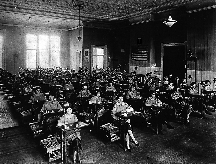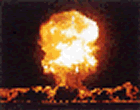History of Radiation Protection
Radiation Protection Basics
Since ancient times, philosophers and scientists have been interested in the basic building blocks of our physical universe. In fact the ancient Greeks were the first to believe that all matter in the universe must be made of tiny building blocks--or atoms. Beginning with the earliest scholars of science throughout history and into this century, scientists have been driven to learn more about the atom and how to control it.
Significant Discoveries
It wasn't until the latter part of the the 19th century that scientists truly began to make advances in the study of atomic structure and radiation.

During the 1800s, Sir Issac Newton had proven his theories on gravity. Marie and Pierre Curie had begun their studies in chemistry and physics, and Dimitri Mendeleev had introduced the periodic system of elements. Just before the turn of the century, Wilhem Conrad Roentgen discovered the basic properties of X-Rays; the properties of ionizing radiation and the possibility of using radiation in medicine.
Finally, in 1896, Henri Becquerel announced the discovery of radioactivity to the Academy of Sciences in Paris. By the early 1900s the study of radiation was a widely accepted scientific endeavor.
New Dangers Come with Discoveries
But, these discoveries did not come without a price. Scientists learned that radiation was not only a source of energy and medicine, it could also be a potential threat to human health if not handled properly. In fact, early pioneers in radiation research died from radiation-induced illnesses (too much exposure). For instance, Thomas Edison's assistant died from a radiation-induced tumor as a result of too much x-Ray exposure. As new uses for radioactive elements were discovered, potentially fatal incidents of overexposure increased. For example, during World War I, radium paint (a mixture of radium and phosphor) was used on military aircraft instruments to make them glow in the dark so they would be more visible to pilots flying at night.

After the war was over, the industry that supported this technology changed their business to paint glow-in-the-dark clocks and watch faces. The young women who were employed in this vocation would form a fine point on their paint brushes by pulling the freshly-dipped brushes between their lips before applying the paint onto the watch faces. Unknowingly, they were swallowing small amounts of radium and damaging their bodies.
Over a two-year period, nine women who had worked as dial painters died of severe and unexplained anemia, accompanied by destructive lesions of the mouth and jawbones. A dentist who had treated one of these women finally made the connection between inflammation of the jawbone marrow, and the radium dial painting.
Meeting the Need for Radiation Protection
By 1915, the British Roentgen Society had adopted a resolution to protect people from overexposure to X-rays. This was probably the first organized effort at Radiation Protection.
By 1922, American organizations had adopted the British protection rules. Awareness and education grew, and throughout the 1920s and 30s, more guidelines were developed and various organizations were formed to address radiation protection in the United States and overseas.

Radiation protection was primarily a non-governmental function until the late 1940s. After World War II, the development of the atomic bomb, and nuclear reactors caused the federal government to establish policies dealing with human exposure to radiation. In 1959, the Federal Radiation Council was established. The Council was responsible for three things:
- advising the President of the United States on radiological issues that affected public health
- providing guidance to all federal agencies in setting radiation protection standards
- working with the States on radiation issues.
In 1970, Congress created the Environmental Protection Agency (EPA) and radiation protection became a part of EPA's responsibility. Today, EPA's Radiation Protection Division (RPD) is responsible for protecting the public's health and the environment from undue exposure to radiation. This is accomplished by setting safety standards and guidelines. Now, organizations that deal with ionizing radiation must meet these standards to comply with the law.
The Radiation Protection Program is responsible for other protection activities too. For example, there is a team of experts that respond to emergencies involving radioactivity. There is also a laboratory that monitors the environment to determine how much radiation is in the air.
![[logo] US EPA](https://webarchive.library.unt.edu/eot2008/20090508081952im_/http://www.epa.gov/epafiles/images/logo_epaseal.gif)